Xuejiao Liu
A 10.60 $μ$W 150 GOPS Mixed-Bit-Width Sparse CNN Accelerator for Life-Threatening Ventricular Arrhythmia Detection
Oct 22, 2024



Abstract:This paper proposes an ultra-low power, mixed-bit-width sparse convolutional neural network (CNN) accelerator to accelerate ventricular arrhythmia (VA) detection. The chip achieves 50% sparsity in a quantized 1D CNN using a sparse processing element (SPE) architecture. Measurement on the prototype chip TSMC 40nm CMOS low-power (LP) process for the VA classification task demonstrates that it consumes 10.60 $\mu$W of power while achieving a performance of 150 GOPS and a diagnostic accuracy of 99.95%. The computation power density is only 0.57 $\mu$W/mm$^2$, which is 14.23X smaller than state-of-the-art works, making it highly suitable for implantable and wearable medical devices.
Genetic Quantization-Aware Approximation for Non-Linear Operations in Transformers
Mar 29, 2024



Abstract:Non-linear functions are prevalent in Transformers and their lightweight variants, incurring substantial and frequently underestimated hardware costs. Previous state-of-the-art works optimize these operations by piece-wise linear approximation and store the parameters in look-up tables (LUT), but most of them require unfriendly high-precision arithmetics such as FP/INT 32 and lack consideration of integer-only INT quantization. This paper proposed a genetic LUT-Approximation algorithm namely GQA-LUT that can automatically determine the parameters with quantization awareness. The results demonstrate that GQA-LUT achieves negligible degradation on the challenging semantic segmentation task for both vanilla and linear Transformer models. Besides, proposed GQA-LUT enables the employment of INT8-based LUT-Approximation that achieves an area savings of 81.3~81.7% and a power reduction of 79.3~80.2% compared to the high-precision FP/INT 32 alternatives. Code is available at https:// github.com/PingchengDong/GQA-LUT.
A 137.5 TOPS/W SRAM Compute-in-Memory Macro with 9-b Memory Cell-Embedded ADCs and Signal Margin Enhancement Techniques for AI Edge Applications
Jul 19, 2023Abstract:In this paper, we propose a high-precision SRAM-based CIM macro that can perform 4x4-bit MAC operations and yield 9-bit signed output. The inherent discharge branches of SRAM cells are utilized to apply time-modulated MAC and 9-bit ADC readout operations on two bit-line capacitors. The same principle is used for both MAC and A-to-D conversion ensuring high linearity and thus supporting large number of analog MAC accumulations. The memory cell-embedded ADC eliminates the use of separate ADCs and enhances energy and area efficiency. Additionally, two signal margin enhancement techniques, namely the MAC-folding and boosted-clipping schemes, are proposed to further improve the CIM computation accuracy.
The QXS-SAROPT Dataset for Deep Learning in SAR-Optical Data Fusion
Mar 15, 2021Abstract:Deep learning techniques have made an increasing impact on the field of remote sensing. However, deep neural networks based fusion of multimodal data from different remote sensors with heterogenous characteristics has not been fully explored, due to the lack of availability of big amounts of perfectly aligned multi-sensor image data with diverse scenes of high resolution, especially for synthetic aperture radar (SAR) data and optical imagery. In this paper, we publish the QXS-SAROPT dataset to foster deep learning research in SAR-optical data fusion. QXS-SAROPT comprises 20,000 pairs of corresponding image patches, collected from three port cities: San Diego, Shanghai and Qingdao acquired by the SAR satellite GaoFen-3 and optical satellites of Google Earth. Besides a detailed description of the dataset, we show exemplary results for two representative applications, namely SAR-optical image matching and SAR ship detection boosted by cross-modal information from optical images. Since QXS-SAROPT is a large open dataset with multiple scenes of the highest resolution of this kind, we believe it will support further developments in the field of deep learning based SAR-optical data fusion for remote sensing.
Boosting ship detection in SAR images with complementary pretraining techniques
Mar 15, 2021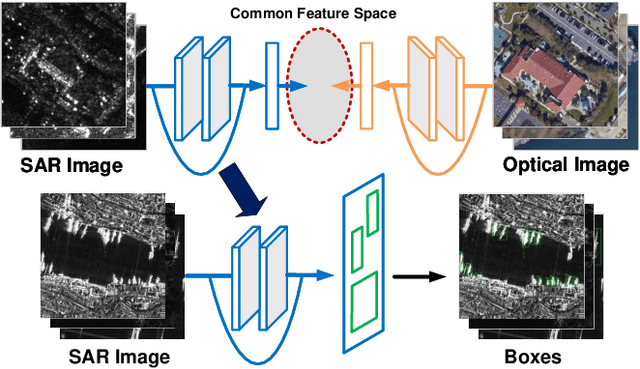
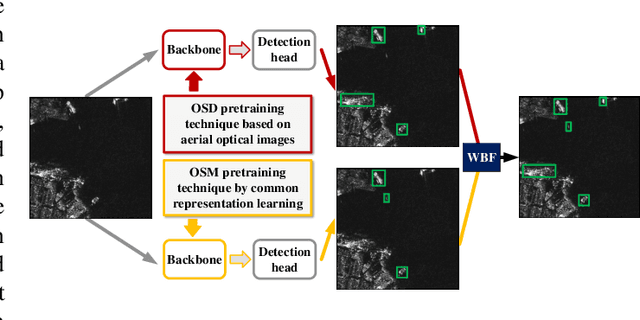

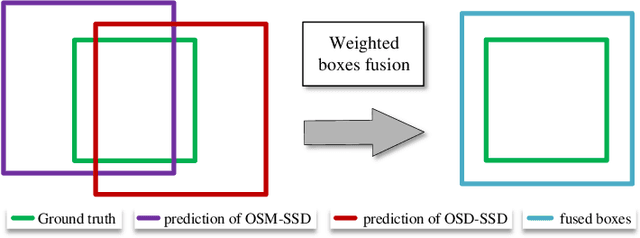
Abstract:Deep learning methods have made significant progress in ship detection in synthetic aperture radar (SAR) images. The pretraining technique is usually adopted to support deep neural networks-based SAR ship detectors due to the scarce labeled SAR images. However, directly leveraging ImageNet pretraining is hardly to obtain a good ship detector because of different imaging perspective and geometry. In this paper, to resolve the problem of inconsistent imaging perspective between ImageNet and earth observations, we propose an optical ship detector (OSD) pretraining technique, which transfers the characteristics of ships in earth observations to SAR images from a large-scale aerial image dataset. On the other hand, to handle the problem of different imaging geometry between optical and SAR images, we propose an optical-SAR matching (OSM) pretraining technique, which transfers plentiful texture features from optical images to SAR images by common representation learning on the optical-SAR matching task. Finally, observing that the OSD pretraining based SAR ship detector has a better recall on sea area while the OSM pretraining based SAR ship detector can reduce false alarms on land area, we combine the predictions of the two detectors through weighted boxes fusion to further improve detection results. Extensive experiments on four SAR ship detection datasets and two representative CNN-based detection benchmarks are conducted to show the effectiveness and complementarity of the two proposed detectors, and the state-of-the-art performance of the combination of the two detectors. The proposed method won the sixth place of ship detection in SAR images in 2020 Gaofen challenge.
How Does GAN-based Semi-supervised Learning Work?
Jul 11, 2020
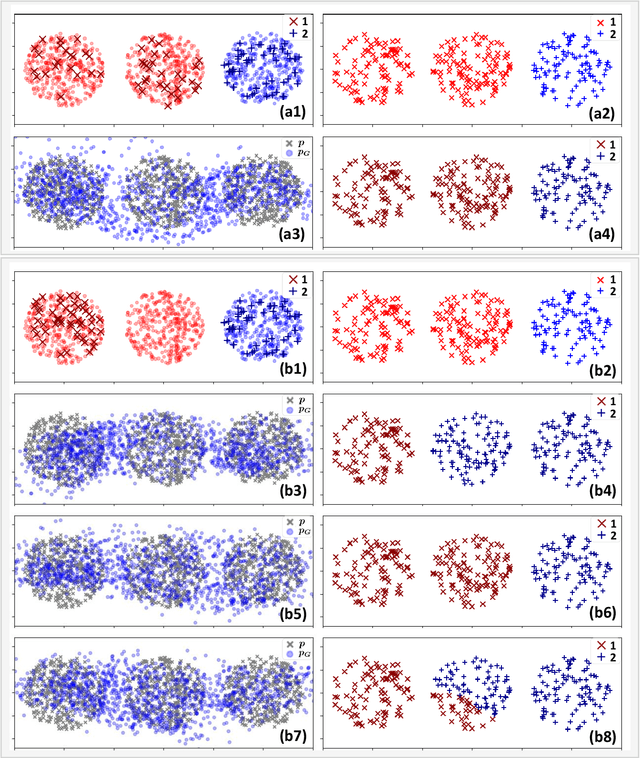
Abstract:Generative adversarial networks (GANs) have been widely used and have achieved competitive results in semi-supervised learning. This paper theoretically analyzes how GAN-based semi-supervised learning (GAN-SSL) works. We first prove that, given a fixed generator, optimizing the discriminator of GAN-SSL is equivalent to optimizing that of supervised learning. Thus, the optimal discriminator in GAN-SSL is expected to be perfect on labeled data. Then, if the perfect discriminator can further cause the optimization objective to reach its theoretical maximum, the optimal generator will match the true data distribution. Since it is impossible to reach the theoretical maximum in practice, one cannot expect to obtain a perfect generator for generating data, which is apparently different from the objective of GANs. Furthermore, if the labeled data can traverse all connected subdomains of the data manifold, which is reasonable in semi-supervised classification, we additionally expect the optimal discriminator in GAN-SSL to also be perfect on unlabeled data. In conclusion, the minimax optimization in GAN-SSL will theoretically output a perfect discriminator on both labeled and unlabeled data by unexpectedly learning an imperfect generator, i.e., GAN-SSL can effectively improve the generalization ability of the discriminator by leveraging unlabeled information.
Towards GANs' Approximation Ability
Apr 10, 2020

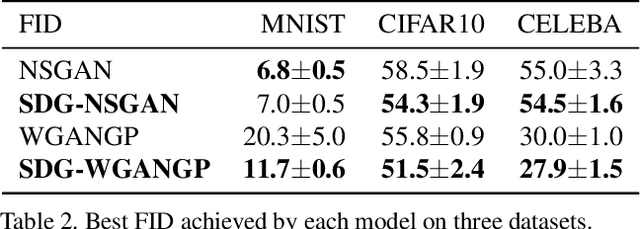
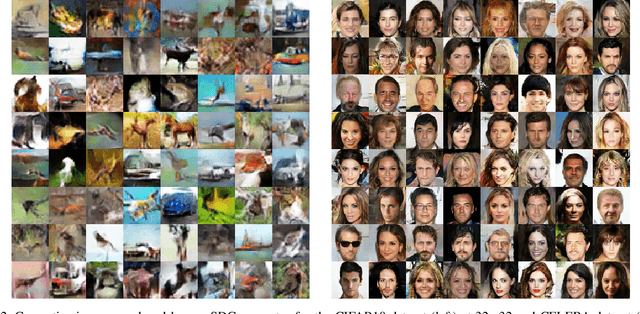
Abstract:Generative adversarial networks (GANs) have attracted intense interest in the field of generative models. However, few investigations focusing either on the theoretical analysis or on algorithm design for the approximation ability of the generator of GANs have been reported. This paper will first theoretically analyze GANs' approximation property. Similar to the universal approximation property of the full connected neural networks with one hidden layer, we prove that the generator with the input latent variable in GANs can universally approximate the potential data distribution given the increasing hidden neurons. Furthermore, we propose an approach named stochastic data generation (SDG) to enhance GANs' approximation ability. Our approach is based on the simple idea of imposing randomness through data generation in GANs by a prior distribution on the conditional probability between the layers. Our approach can be easily implemented by using the reparameterization trick. The experimental results on synthetic dataset verify the improved approximation ability obtained by this SDG approach. In the practical dataset, the NSGAN/WGANGP with SDG can also outperform traditional GANs with little change in the model architectures.
 Add to Chrome
Add to Chrome Add to Firefox
Add to Firefox Add to Edge
Add to Edge